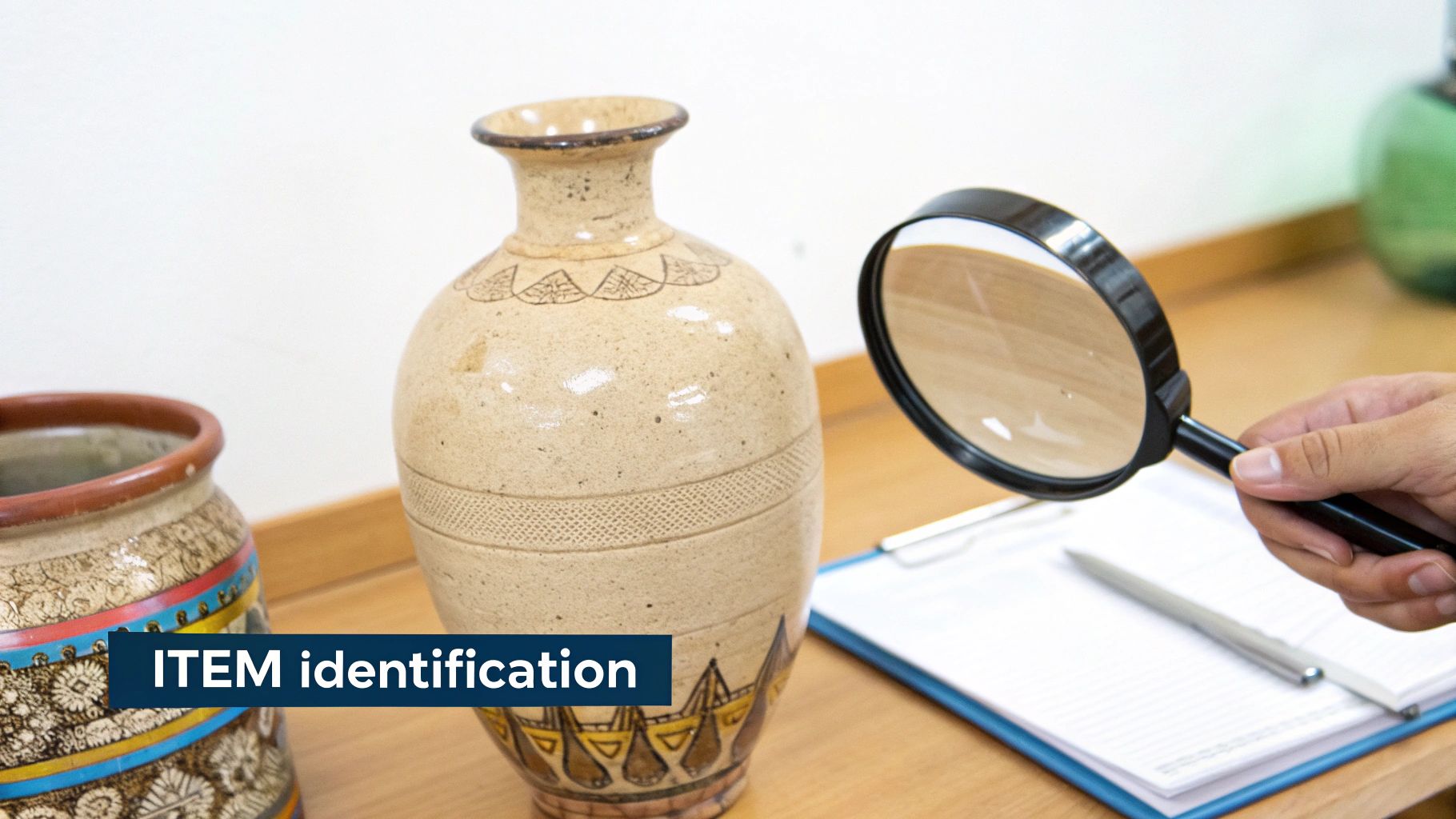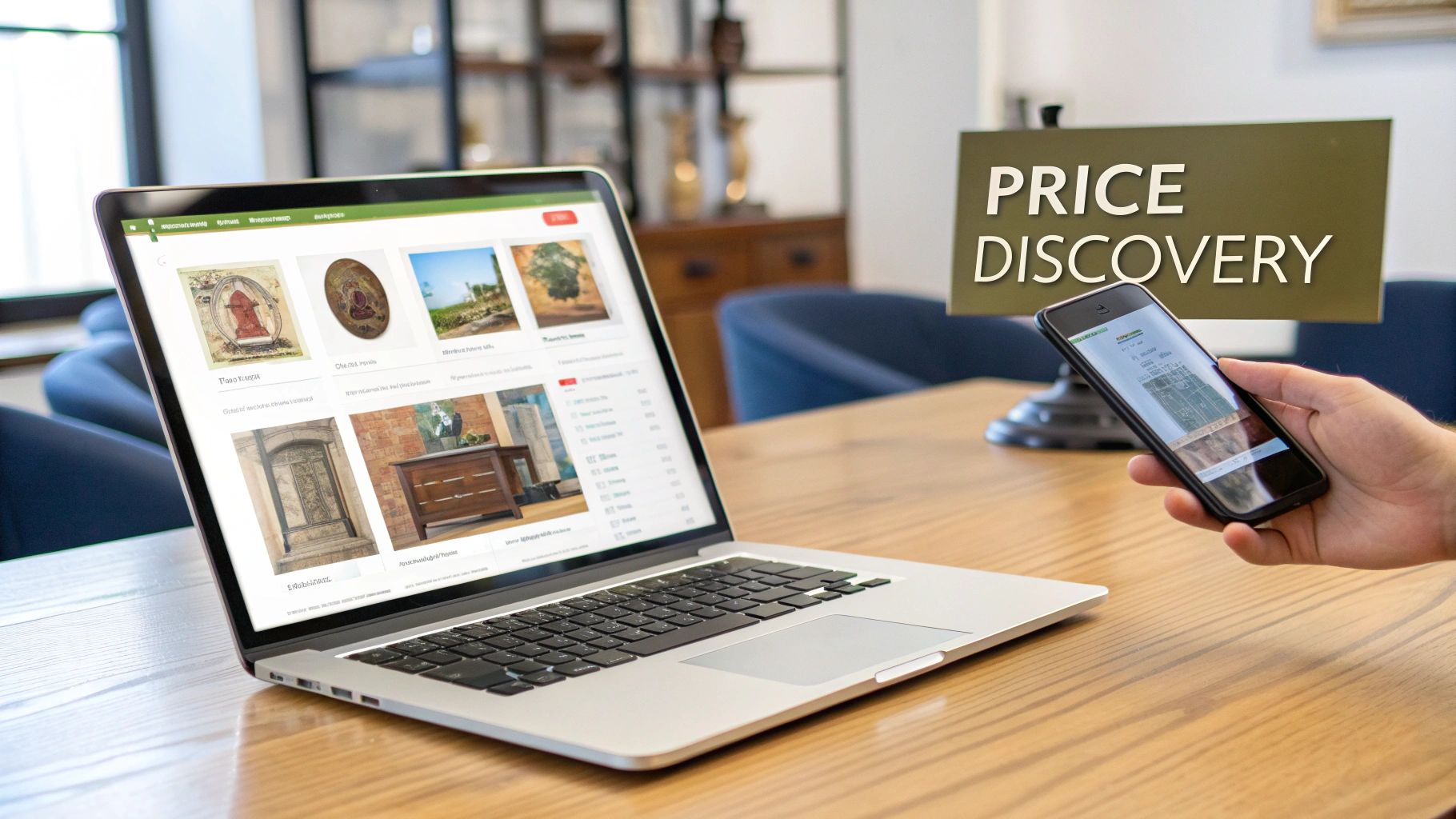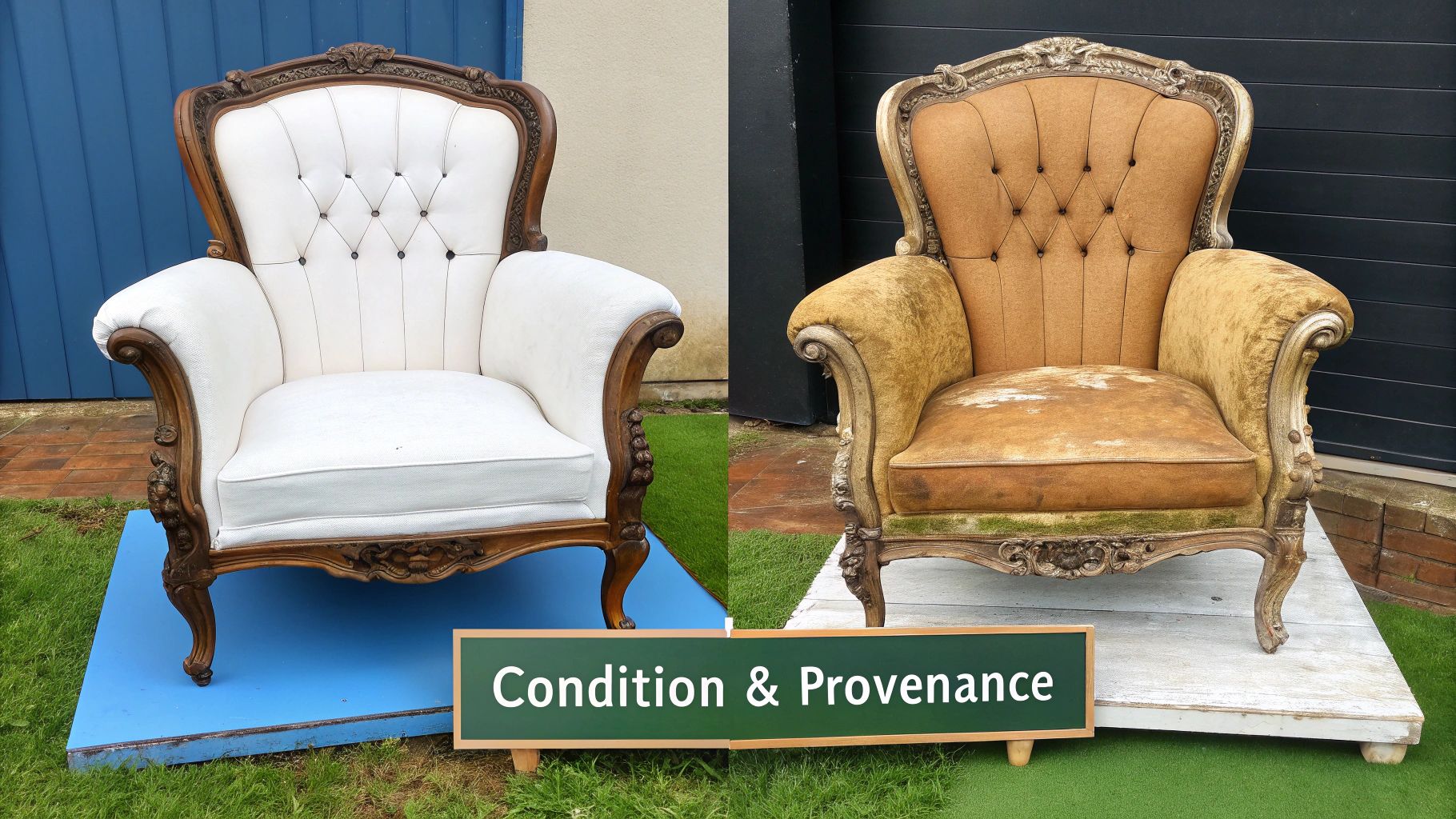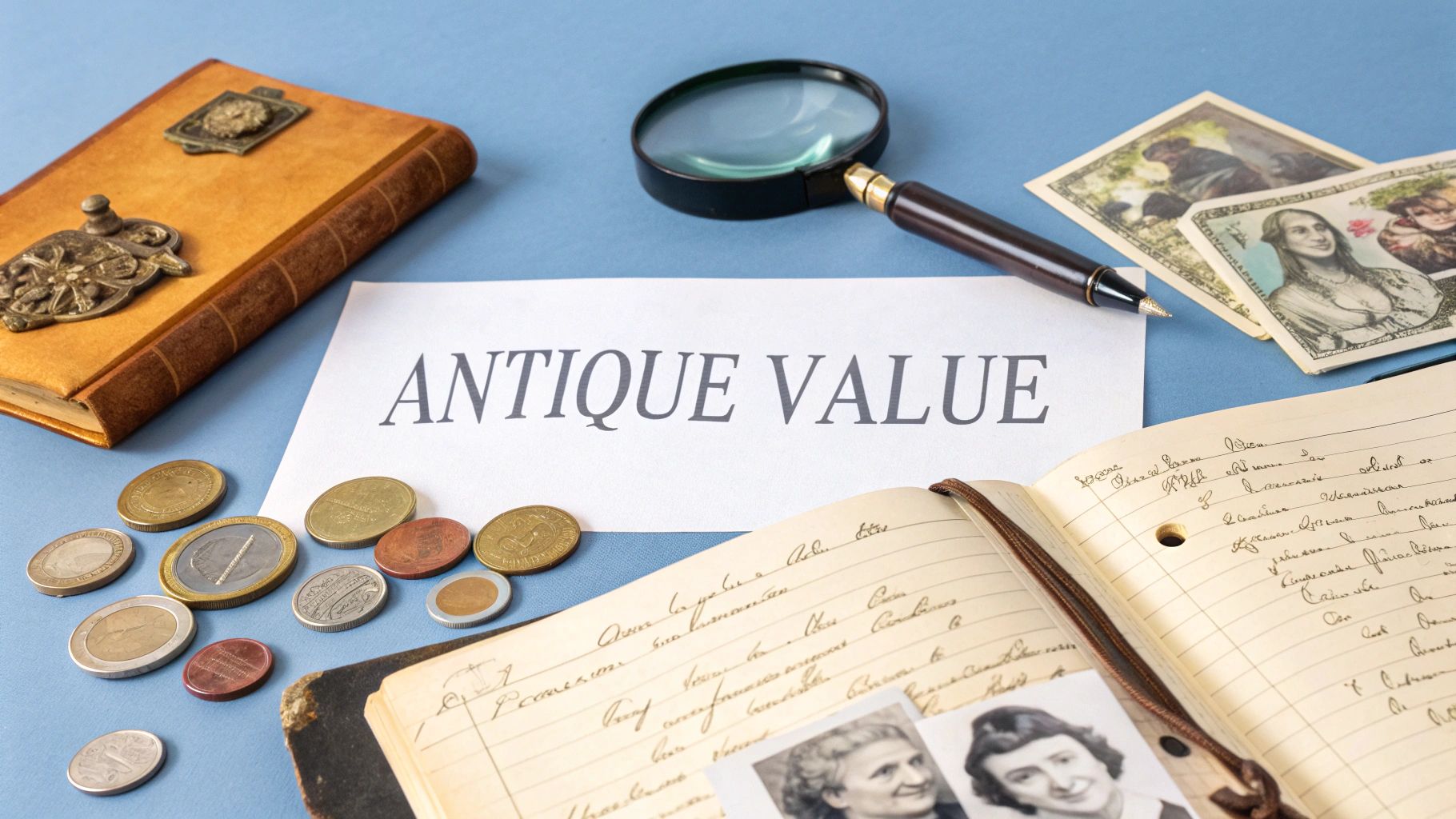Have you ever held an old family heirloom and thought, "I wonder what this is actually worth?" It's a common question, and the answer is never a simple price tag. It's more like a puzzle, with pieces of its history, condition, and what people are looking for right now all fitting together. An antique's value can swing wildly, from less than $20 for a common, damaged piece to over $10,000 for something truly rare with a solid history.
What Determines Your Antique's Worth
That object in your hands isn't just old; it's a tangible piece of history with a story to tell. Learning what makes an antique valuable is the first real step to figuring out its market price. This isn't about guesswork or how much it means to you personally. It’s about learning to see the item through the eyes of a professional appraiser.
To do that, you need to go beyond a quick online search and understand the key factors that serious collectors and dealers always look for. Whether you want to sell, get insurance, or just satisfy your curiosity, I'll walk you through the process, breaking it down into clear, manageable steps.
A Quick Look at the Core Value Factors
Certain qualities consistently push an antique's price up or down. Think of these as the main ingredients in the recipe for value. Getting a handle on them is crucial before you dive any deeper into your research.
Here are the big four that professionals always consider:
- Rarity: How many of these were made, and how many are left? A one-of-a-kind piece or something from a limited run will almost always be more sought-after than a mass-produced item.
- Condition: Is the item in its original, untouched state? Or does it have cracks, chips, repairs, or signs of restoration? Collectors will pay a premium for originality.
- Provenance: This is the item's life story—its paper trail of ownership. A documented history connecting it to a famous person, a historical event, or a well-known collection can send its value soaring.
- Aesthetics and Desirability: Simply put, is it beautiful? Is it a style that’s currently in fashion with collectors? Market trends play a huge part in what's hot and what's not.
The global antiques and collectibles market was valued at around USD 238.1 billion in 2024, which gives you a sense of just how massive this world is. That entire market is built on the interplay of these core factors. You can get more insights into current collectibles market trends to see how things are shifting.
Expert Tip: An antique's value is a blend of its physical traits (rarity, condition) and its story (provenance, desirability). To fetch a high price, an item usually needs to score well in most, if not all, of these categories.
Let's break these factors down into a quick reference table. This is a great way to see, at a glance, what appraisers are trained to look for.
Core Factors That Drive Antique Value
A quick overview of the key elements professionals consider when appraising an antique. Each factor plays a crucial role in the final valuation.
| Factor | What to Look For | Why It's Important |
|---|---|---|
| Rarity | Limited production runs, unique features, or one-of-a-kind items. | Scarcity creates demand. If few exist, collectors are willing to pay more to own one. |
| Condition | Original finish, no repairs, minimal wear, completeness (all original parts). | Pristine, original condition is the gold standard and commands the highest prices. |
| Provenance | Ownership history, old receipts, letters, photos, or auction records. | A documented story adds historical significance and confirms authenticity, increasing value. |
| Desirability | Current market trends, aesthetic appeal, maker's reputation. | Value is tied to demand. An item is only worth what someone is willing to pay for it today. |
Keep these four pillars in mind as you start your investigation. They are the foundation upon which every antique's market value is built.
Your First Step: Play Detective with Your Item

Before you can even begin to guess at an antique's value, you need to become an investigator. This initial hands-on inspection is where the magic happens; it's where you'll find the clues that unlock your item's story and, ultimately, its worth. Your job is to find the "fingerprints" left behind by the person who made it.
These identifiers are often hiding in plain sight. For glassware or ceramics, flip the piece over and check the bottom. With furniture, you'll want to pull out drawers, look at the back panels, or even get on the floor and check underneath.
Look for Maker's Marks and Signatures
A maker's mark is your single best clue. It’s a symbol, name, or series of letters that the manufacturer stamped, impressed, or painted onto the item. A signature, which is common on artwork, is the handwritten name of the artist or craftsman.
Think of these marks as a secret code. On an old silver spoon, for instance, a series of tiny symbols called hallmarks can tell you the city where it was assayed, the purity of the silver (92.5% for sterling), and even the exact year it was made. Learning how to identify antiques using these marks is a skill that pays dividends.
Assess the Materials and Construction
Beyond any official marks, the object itself tells a story. Pick up that side table. Does it feel unusually heavy? It might be solid mahogany instead of a lighter pine or, more commonly, a piece with a thin wood veneer. Getting a feel for different materials is a fundamental part of the appraisal process.
Here are a few things I always look for:
- Solid Wood vs. Veneer: Check the edges of a tabletop or drawer front. If the wood grain pattern wraps continuously from the top to the side, it's likely solid wood. If you see a seam or a different grain pattern on the edge, you're probably looking at a veneer.
- Sterling Silver vs. Silver Plate: Real sterling is almost always marked. Look for the word "Sterling," the number "925," or a lion symbol (on British silver). If you find markings like "EPNS" (Electro Plated Nickel Silver), you have a silver-plated item, which has a much lower value.
- Porcelain vs. Earthenware: This one's a neat trick. Hold a plate or teacup up to a strong light. True porcelain is translucent, and you should be able to see the shadow of your fingers through it. Earthenware, on the other hand, is completely opaque.
My Pro Tip: Document everything. Take clear, well-lit photos of the entire item, close-ups of any marks or signatures you find, and any interesting construction details like dovetail joints. These notes and pictures will become your research "dossier" and are absolutely essential for the next steps.
Uncovering Your Antique’s Value Online
You've done the hard work of building a detailed profile of your antique. Now, it's time to put that information to work and dive into the most powerful valuation tool we have today: the internet. Forget dusty library archives; the digital age has brought real-world market data right to your screen. The trick is knowing where to look and, more importantly, how to interpret what you find.
A quick search for "old gold clock" will throw thousands of useless results your way. That’s not what we’re doing here. Your goal is to use those specific details you gathered—the maker, materials, style, and dimensions—to find what professionals call "comparables" or "comps." These are documented sales records of items that are either identical or incredibly similar to yours.
Focus on What Actually Sold, Not Just What's for Sale
Here's a critical piece of advice: the most reliable indicator of an antique's market value is what a real person has already paid for a similar item. Asking prices on sites like eBay or Etsy can be misleading; they often represent what a seller hopes to get, not what the market is willing to bear.
The real gold is in completed auction results. This is where auction databases come in—they are treasure troves of hard data.

Platforms like LiveAuctioneers maintain vast archives of sold items. By digging into their records, you can see exactly what pieces like yours have fetched at auction, giving you a solid, evidence-based starting point for its value.
What if your item has no markings? Try an image recognition tool like Google Lens. Just snap a photo, and the app will scan the web for visually similar items. It's not foolproof, but it can be surprisingly effective at pointing you toward the right keywords for a more focused search.
Crafting the Perfect Search Query
The quality of your search results is a direct reflection of the quality of your search terms. Be precise. This isn't just a casual browse; you're conducting targeted research. The online market for antique furniture alone is estimated to be worth $34 billion globally, and it’s all driven by precise data. You can learn more about this incredible growth from reports on the future of the online antiques market.
To get the best results, build your search query piece by piece:
- Start with the object type: "Mantel Clock," "Sideboard," or "Vase."
- Layer in the style or period: "French Empire," "Mid-Century Modern," or "Art Deco."
- Add the material: "Bronze," "Mahogany," or "Porcelain."
- Finish with the maker, if you have it: "Ansonia," "Stickley," or "Limoges."
This transforms a vague search like "old gold clock" into a highly specific query: "19th Century French Empire Gilt Bronze Mantel Clock." This is the level of detail that cuts through the online clutter and delivers the comps you actually need.
This targeted method allows you to establish a confident, narrow value range based on what the market is actually doing. For a deeper dive, our comprehensive price guides for antiques can show you how these values shift across different categories. https://www.curio.app/blog/price-guides-for-antiques
Top Online Tools for Antique Valuation
Navigating the web for reliable data can feel overwhelming, but a few key platforms stand out. I've used these countless times to pinpoint the value of everything from common collectibles to rare decorative arts. Each has its own strengths, so knowing which one to use for your specific item is key.
| Online Resource | Best Used For | Typical Cost | Insider Tip |
|---|---|---|---|
| LiveAuctioneers | Finding auction "hammer prices" for a huge range of decorative arts, furniture, and fine art. | Free to search sold items, but you'll need an account. | Pay attention to the auction house location. Prices for the same item can vary significantly between a major city and a regional auction. |
| WorthPoint | Comprehensive research across multiple sources, including eBay's history and various auction houses. Great for collectibles. | Subscription-based (monthly fee). | Use their "Marks, Autographs, Patterns & Symbols" (MAPS) database to identify tricky maker's marks you couldn't find elsewhere. |
| Invaluable | Similar to LiveAuctioneers, offering a large database of past auction results, especially strong for fine art. | Free to search sold items with an account. | Check the "price realized" which includes the buyer's premium. This gives you the total price the buyer paid, a more accurate market value. |
| Google Lens | Identifying unmarked items or finding the right keywords when you don't know where to start. | Free. | After your initial image search, use the keywords it suggests to do a more refined text search in one of the auction databases. |
These platforms aren't just search engines; they are your window into the real-time antiques market. Using them effectively is the difference between making a wild guess and making a data-driven valuation.
How Condition and Provenance Impact Value

Ever wonder why two antique chairs that look almost identical can have wildly different price tags? One might be worth $100, while the other fetches $1,000. The answer almost always boils down to two critical factors: condition and provenance. If you really want to understand what your antique is worth, you have to get a handle on these two concepts.
Condition is so much more than a quick once-over. Serious collectors are on the hunt for pieces in pristine, original condition—that means no repairs, no swapped-out parts, and no major damage.
But don't mistake signs of age for damage. There's a world of difference between honest wear and tear, which we call patina, and a flaw that tanks an item's value. That gentle fading on a piece of old fabric or the warm, mellow glow on a well-used wooden table tells a story. For many collectors, that story adds to the charm and the price.
On the other hand, a crack in a porcelain plate, a big chip in a glass vase, or a clumsy, obvious repair will always drag the value down.
Distinguishing Wear from Damage
Learning to tell the difference between acceptable aging and outright damage is a skill you develop over time. I’ve seen countless pieces ruined by a well-intentioned but amateur repair—like modern glue on a 19th-century chair. That alone can destroy its value.
Even professional restoration, while sometimes needed to save a piece from falling apart, can be a turn-off for purists. They want originality, period.
When you're looking over your item, keep an eye out for these tell-tale signs of a past repair:
- Color Mismatches: A slightly different shade of paint or a patch of wood stain that doesn't quite match is a dead giveaway.
- Unusual Textures: Run your hand over the surface. If one spot feels smoother or rougher than the rest, it could be a filled-in chip or a sanded-down area.
- Signs of Modern Materials: Modern screws, shiny new glue, or synthetic fabrics on an old piece of furniture are huge red flags. It screams "I've been fixed!"
An antique in good, original condition is always worth more than the same item that has been poorly restored. Originality is the gold standard for most collectors, and any alteration can significantly impact its market value.
The Power of a Good Story
Beyond its physical state, an item’s history—its provenance—can make its value skyrocket. Provenance is simply the documented history of ownership. It’s the paper trail that proves where an object has been since the day it was made.
Think about it. An old writing desk is nice. But what if you also have a stack of family letters and a faded photograph showing your great-great-grandfather sitting at that very desk? Suddenly, it’s not just a piece of furniture. It’s a tangible piece of your family’s history.
This verifiable story is what makes provenance so compelling. Was your item owned by someone famous? Did it once sit in a historic home? Can you trace its ownership through old receipts, wills, or other documents? Any scrap of evidence that links your antique to a specific person, place, or time adds a layer of desirability that collectors are willing to pay a premium for. Digging into your item’s backstory can be the most rewarding part of the appraisal process, and it just might turn a simple find into a real treasure.
When You Need a Professional Appraiser
Doing your own homework with online databases and auction records is a fantastic way to get a solid ballpark figure for your antique. I always recommend it. But sometimes, a "good guess" just doesn't cut it.
There are moments, especially when the stakes are high, where nothing can replace the expertise and legal weight of a certified professional appraisal. Think of it this way: your research builds the story of your item's value, but a formal appraisal is the final, legally recognized chapter. If you need a number that will hold up under official scrutiny, it's time to bring in an expert.
High-Stakes Scenarios That Call for an Appraisal
Certain situations demand a formal, written valuation. A quick price estimate from a local auction house, while helpful, won't work here. You need a thoroughly researched legal document that you pay for—a certified appraisal.
Here are the most common times you'll need to hire a pro:
- Insurance Coverage: To properly insure a valuable piece, you'll need an official appraisal to establish its replacement value. This figure is often much higher than the fair market value because it reflects what it would cost to buy a similar item from a retail dealer on short notice.
- Estate Settlement: When an estate or trust is being divided, a formal appraisal ensures a fair, unbiased valuation. This is crucial for preventing disputes among heirs and satisfying legal and tax requirements.
- Charitable Donations: If you’re donating a valuable antique and want to claim a significant tax deduction, the IRS is going to ask for proof. They require a "qualified appraisal" from a "qualified appraiser" to back up the item's worth.
- Selling a Big-Ticket Item: For truly rare or expensive pieces, a professional appraisal gives potential buyers immense confidence. It’s a credible, third-party valuation that can justify a premium price and smooth out the negotiation process.
It's crucial to understand the difference. An auction estimate is a free opinion of what your item might fetch on a good day at that specific auction. A certified appraisal is a paid, detailed report that provides a defensible statement of value for legal, financial, or insurance purposes.
Finding a Qualified Expert
Here's a critical piece of advice: not all appraisers are created equal. You're looking for someone who not only has deep knowledge but also adheres to strict ethical and professional standards.
The best place to start your search is with the major professional organizations that vet their members. Groups like the Appraisers Association of America (AAA) and the International Society of Appraisers (ISA) are the gold standard in the industry.
Their websites have searchable databases that let you find a certified appraiser who specializes in your exact type of antique, whether it's 18th-century furniture or mid-century glass.
Using these directories is the surest way to find a professional who has proven their expertise and follows the Uniform Standards of Professional Appraisal Practice (USPAP). For a deeper dive, our guide on getting a formal appraisal for antiques has more tips on vetting and choosing the right person for the job.
When you contact an appraiser, be ready with questions. Ask about their specific experience with items like yours, their fee structure, and exactly what their final report will include. Getting this clear upfront ensures there are no surprises and that you receive precisely the documentation you need.
Got Questions About Your Antique's Value? We've Got Answers.
Once you’ve done a bit of digging, you’ll probably find yourself with more questions than when you started. That's completely normal. The world of antiques is full of nuance, where a small detail can change everything.
Let's walk through some of the most common questions that pop up when you're trying to pin a real number on an old treasure. Getting these straight will save you a world of headache and disappointment down the road.
What's the Difference Between Market Value and Insurance Value?
This is a big one, and mixing them up can lead to some serious confusion. They sound similar, but they're two totally different numbers for two very different reasons.
- Market Value: Think of this as the "cash-in-hand" price. It's what a real person would likely pay for your item today, whether at an auction, from a dealer, or online. It’s a reflection of current demand and what the market will bear right now.
- Insurance Value: This is the "replacement" cost. It’s always a higher figure because it represents the full retail price to buy a nearly identical item from a high-end dealer, often on short notice. It has to account for the dealer's markup and the difficulty of finding that specific piece again.
So, be crystal clear about which number you need. If you ask an appraiser for an insurance value but you're actually planning to sell, you’ll be setting yourself up for an unrealistic expectation.
Will Restoring My Antique Make It Worth More?
Probably not. In fact, it’s one of the fastest ways to tank an antique's value. Serious collectors almost always want pieces in their original, untouched condition.
Now, a careful, professional repair to make something stable—say, fixing a wobbly leg on a table—can help preserve its value. But we're talking about stabilization, not a makeover.
A Word of Warning: Aggressive "restoration" like stripping the original finish, slapping on a new coat of paint, or polishing away a beautiful old patina can slash an antique's value by 50% or more. Those signs of age and use are part of its story, and often, that's exactly what a buyer is looking for.
Think of it this way: a collector wants the real, authentic story of the piece. A heavy-handed restoration just erases that history.
If It’s Old, It Must Be Valuable, Right?
That's one of the biggest myths out there. While an item generally needs to be at least 100 years old to be technically called an antique, age alone doesn't make something valuable. Not even close.
What really drives value are things like rarity, condition, maker, and desirability. I've seen 120-year-old, mass-produced chairs that are barely worth a few dollars. On the flip side, a rare piece of designer furniture from the 1960s—which is technically "vintage," not antique—can be worth a fortune.
It all comes down to what the market wants. Demand, not just age, is king.
Can I Really Get a Free Antique Appraisal?
You can get a free opinion of value, but that's a far cry from a formal, written appraisal. Many auction houses host free valuation days or offer online estimates, which are fantastic for getting a ballpark idea of what your piece might fetch.
Just remember their goal is to get you to sell with them. What they're giving you is a verbal auction estimate, not a legally binding document.
If you need a valuation for official purposes—like for an insurance policy, an estate settlement, or a tax-deductible donation—you need to hire and pay a certified appraiser. They'll give you a detailed, thoroughly researched report that will hold up with the IRS, lawyers, and insurance adjusters.
Feeling like you're in over your head? The Curio app is like having an antique expert in your pocket. Just take a picture to instantly identify your item, dive into its history, and get a reliable appraisal without the guesswork. Download Curio today and start uncovering the stories hiding in your treasures.
